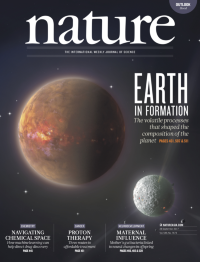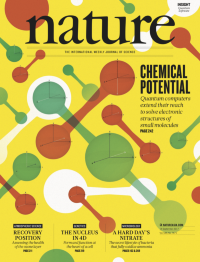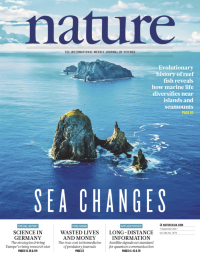Volume 549
-
No. 7673 28 September 2017
Earth was formed through the collisions of countless planetesimals. These building blocks are today represented by meteorites, the elemental compositions of some of which, the carbonaceous chondrites, are thought to reflect the chemistry of the early Solar System. As such, Earthâs chemical make-up ought to be similar to these meteorites and in many respects it is. Earth is, however, strongly depleted in moderately volatile elements such as lead, zinc and indium. A potential explanation for these depletions is that these elements evaporated from molten rock during the planet-forming processes and in this weekâs issue, Ashley Norris and Bernard Wood interrogate this idea further, resolving some of the inconsistencies seen in earlier proposals. By melting basaltic rock in a furnace under controlled conditions, the researchers examined the melting processes that would have occurred during the accretion of Earth and its precursor bodies. They found that the pattern of depletion of volatile elements is consistent with partial melting and vaporization of the early Earth, and suggest that this occurred on small molten precursors or during energetic collisions â such as the violent impact with Earth that formed the Moon. The cover shows one such instance of the proto-Earth and a nearby planetesimal. Heated by collisions and the decay of aluminium-26, the bodies degas volatile elements, forming thick atmospheres, which are ultimately swept to interstellar space by the solar wind, removing the volatile elements from the final composition of the planet. In related work, Remco Hin and his colleagues provide further evidence to support the idea of vaporization by the measuring the ratios of magnesium isotopes in Earth, Mars and some asteroids. Cover image: C. Ashley Norris
-
No. 7672 21 September 2017
When a proliferating population of cells completes mitosis, some of the newly born daughter cells immediately enter the next cell cycle whereas other cells switch to a quiescent state. In this weekâs issue, Tobias Meyer and his colleagues reveal how competing memories inherited from the mother cells lead the daughter cells to decide whether to stop or start the subsequent cell cycle. Growth signals cause an accumulation of cyclin D1 messenger RNA in the mother cells, whereas DNA damage leads the cells to contain a higher amount of activated p53. These are passed on to the daughter cells, where the cyclin D1 mRNA is translated into protein and p53 promotes production of the protein p21. Daughter cells that inherit larger amounts of cyclin D1 continue through to the next cell cycle, and those that have a high amount of activated p53 move into quiescence. This results in a system of cell-cycle control that maximizes the health of growing cell populations by preferentially selecting cells with a history of low DNA damage for more frequent proliferation. Cover image: Jeroen Claus/Phospho Biomedical Animation
-
No. 7671 14 September 2017
Quantum chemistry is one of the most promising applications for quantum computers. However, to date only the smallest molecular systems have been simulated experimentally by quantum hardware. In this weekâs issue, Abhinav Kandala, Antonio Mezzacapo and their colleagues present simulations of larger molecular systems using a variational quantum eigenvalue solver implemented on a superconducting quantum processor. Their variational quantum eigensolver is hardware-efficient, which means that it is optimally implemented on the given architecture. With this approach, they have been able to extend quantum chemical calculations to LiH and BeH2, and have also applied their technique to a problem in quantum magnetism. The errors in the implementation are understood by supporting numerical simulations, and the authors believe that the mitigation of incoherent errors would be an important step towards eventually yielding a simulation of interesting molecular systems on a quantum computer. Cover image: Carl De Torres
-
No. 7670 7 September 2017
The cover shows the Martin Vaz Islands, part of the archipelago of Trindade and Martin Vaz that lies some 1,170 kilometres east of Brazil. These volcanic islands were at the heart of a study by Hudson Pinheiro and his colleagues that examined the evolutionary history of reef fish living in the inshore waters of the archipelago. Island biogeographers tend to concentrate on the terrestrial residents of islands, and how sea-level change, invasion and endemism influence diversity. Less attention has been paid to the marine organisms that make the waters around islands their home. The study of reef fish by Pinheiro and his team helps shed light on the processes that shape the aquatic environments of islands. The researchers found that sea-level changes have helped to drive marine speciation, but because fish are better at dispersing than land-based organisms, the influx of immigrants helps to drive an increase in diversity. As a result, the authors conclude that island geography, geological history and sea-level fluctuations influence the dispersal of marine organisms in different ways from the effect on land-based organisms. Cover image: Joã£o Luiz Gasparini




